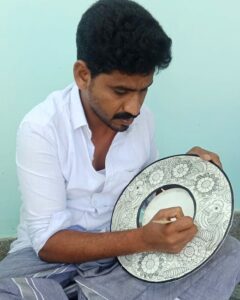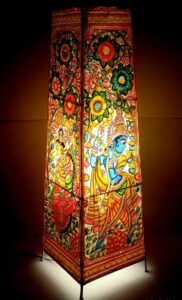Tholu Bommalata: Shadow puppetry art of Andhra Pradesh

Leather puppets are made from goatskin that is transformed into a translucent parchment through an arduous process of washing and cleaning (Photo: Kandey Anjanappa)
As soon as lights go off, a loud voice, along with classical music, booms and different characters leap onto white screen. The latest show of Tholu Bommalata has begun. Deeply connected with spiritual beliefs and cultural practices, this shadow puppetry mainly depicts narratives from epics like the Mahabharata and Ramayana, blending them with local customs, social issues and passing culture from one generation to another to keep this form alive.
Traditional techniques of leather puppetry
Leather puppets are made from goatskin that is transformed into a translucent parchment through an arduous process of washing and cleaning. After it is completely clean, the hide is marked out with the outlines of the figures of the puppets, punching holes in between, as the numerous little windows create a sparkling effect when held against light, adding to the beauty and attraction of the show.

An average puppet takes up to four days to complete
The outlines are then marked with black ink using a bamboo nib. After this, the leather is coloured in vibrant hues such as red, green, yellow and more. To make the puppets, individual parts or organs of the puppet, like legs, arms or head, are cut and then stitched together. The puppet is then mounted on sticks and bound with ropes to facilitate free movement. An average puppet takes up to four days to complete and a considerable amount of talent as well.
The origins
As was usual with folk arts, this art was also patronised and believed to have originated in 200 BC during the rule of Satavahana dynasty. Thanks to royal patronage, the art and artisans flourished across peninsular India, from Maharashtra to Odisha and southwards to Karnataka, Tamil Nadu and Kerala.
However, over the centuries, with changes in rulers and their tastes, the art suffered and survived only in various pockets in different states. Today, the main centres of this art are located in Andhra Pradesh, though the art is also found in most other states of eastern and southern India.
Nimmalakunta, a small village in Anantpur district, is considered to be home of Tholu Bommalata as the art has been handed down for generations and the practice continues even today and almost every household practices it as part of their culture as well as the principal source of livelihood.

Artist Kandey Anjanappa explains his art work to IAS officials
“We have been practicing this art form for more than seven generations. My father told me that his grandparents, also engaged in the art, migrated from Maharashtra to Andhra Pradesh, to earning and settled here. I have also picked up this art, but I end up spending day and night to complete a simple puppet and most of the times, as there are not too many buyers always around, I get only little money,” Kandey Anjanappa, a well-known artist, who hails from Nimmalakunta, tells Media India Group.
Folk art on verge of becoming folk tale
With the advent of other media of entertainment and specially since the arrival of the internet and the boom in smartphones over the past decade. As a result, today there has been a sharp decline and the artists complain that there are few people who are interested in this art and even fewer buyers, making it very difficult, or even impossible, to make it their sole source of income.
“It’s only the festival or temple occasions, when people remember us. We don’t even get two bookings in a month as it seems that people today prefer to get their entertainment from films and their smartphones rather than their culture and heritage,” says Kandey.
Kandey is not the only one to blame technology and modern entertainment for the fate of the leather puppetry art.
“All the upcoming technology is gradually a major reason for fading away of cultural and traditional art forms as unfortunately people in India don’t value their rich culture and heritage,” says Vinati Bhatt, artist and founder of Folk by Discovery of India, a New Delhi based NGO that has been working to revive and indeed promote traditional arts and crafts of India.
Bhatt has been teaching children different kinds of folk arts for over two decades. She says that India has a large number of art forms, both tangible like painting and puppetry or intangible like storytelling. All these have been used for thousands of years to pass the knowledge of Indian epics, music, dances, local legends and other jewels of Indian heritage, through the generations, she adds.
“Folks arts have rendered a great service in spreading knowledge to everyone, word of mouth was expressed in interesting manner with the help of music when there was no other mode or today’s technologies,” Bhatt tells Media India Group.
However, she despairs that this immense wealth of culture and heritage is threatened as nowadays, people don’t even spend one or two hours to watch any kind of cultural folk activities. “And as a result, there are many art forms which are depleted, many are still on the edge of extinction because there is no patronization,” cautions Bhatt, adding that people have stopped respecting our traditional knowledge, heritage and arts and craft.
“People think they are over exposed, that is the reason they never value to learn these kinds of art forms, we should blame ourselves for not putting any efforts to learn any folk arts and crafts,” says Bhatt.
She says that as a result of this widespread neglect, most of the artists have been pushed to limits of desperation. “It is a kind of desperate attempt to survive. I have seen a lot of artists who struggle to sell their handmade products at a cheap rate as people don’t value the efforts behind this and many other art and craft,” tells Bhatt.
As they themselves struggle to survive, the artists are not keen that their own children follow them on this career path. “This lack of appreciation, neglect and the struggle to survive are the reasons nowadays most artists are firmly against their children learning this art form as a means of livelihood,” says Bhatt.

Reviving this art in interior designing
To revive the art and to help the artisans survive and find new markets for their talent, Bhatt has begun to get them to make household goods like lamps, paintings and wall hangings as well as modern puppets which are popularly used in interior designing nowadays. With a rich repertoire of over 150 such items to be made, the Tholu Bommalata artisans have now found a way to showcase their talent to the world and earn a livelihood as well as respect of art lovers.
Fortunately, the original art form of Tholu Bommalata, the shadow puppetry, has continued to survive in rural areas of several states like Odisha, Kerala, Karnataka, Maharashtra and Tamil Nadu.
Kandey says that after decades of neglect, the government seems to be finally coming to the aid of the artisans by organising exhibitions and also by helping them export their work.
“It is a huge process to complete a single puppet and then often we would end up spending twice as much time in finding a buyer. For us, sometimes even domestic exhibitions don’t work out as we have to pay to participate and the sale is not so high. But exports are important and there the government’s help has been crucial,” says Kandey, who has participated, thanks to support from the Indian government, in various exhibitions in Germany, United Kingdom and the United Arab Emirates.










